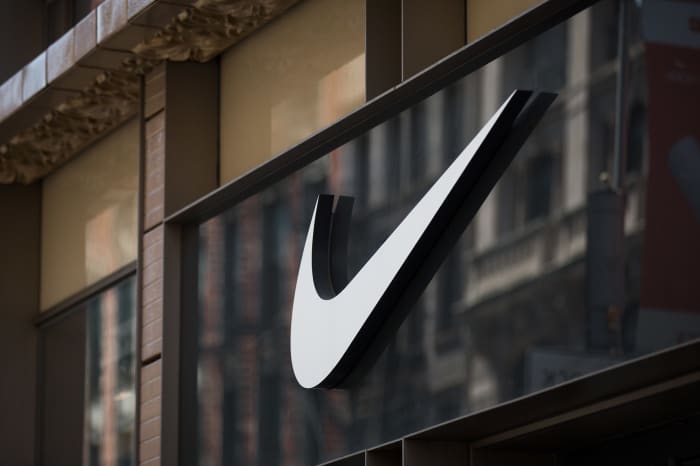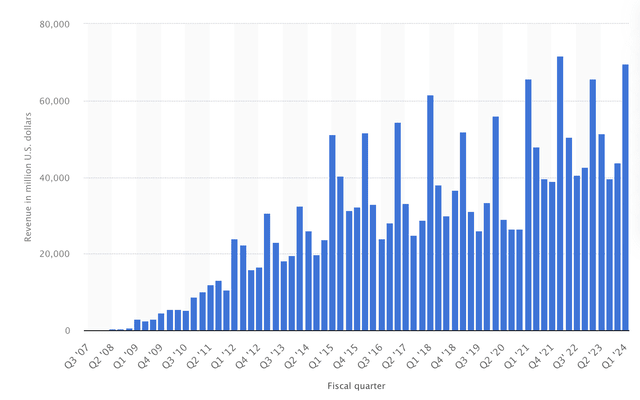Nike shares dive after company eyes $2 billion in cost cuts amid ‘softer’ outlook
December 23, 2023 | by stockcoin.net


Nike shares took a sharp dive, plummeting over 11% in after-hours trading following the company’s revelation of a “softer” revenue outlook during its earnings call. In response, the athletic apparel giant has set its sights on extensive cost-cutting measures of $2 billion over the next three years. With plans to streamline operations, shed management positions, and redirect its focus towards its Jordan brand and women customers, Nike aims to increase efficiency by simplifying its product selection and implementing automation and technology. Alongside cost reduction efforts, the company has initiated layoffs, projecting restructuring costs of approximately $400 million to $450 million. Although Nike has lowered its expectations for sales growth in the coming quarters, anticipating only a 1% increase for the full fiscal year, it remains committed to reinvesting its savings into enhancing its agility and responsiveness to consumer preferences, despite facing weakening demand and intense price-cutting competition.
▶ [Kucoin] Transaction fee 0% discount CODE◀
Nike shares dive after company eyes $2 billion in cost cuts amid ‘softer’ outlook
Introduction to the article
Nike, the renowned sportswear and athletic footwear company, recently experienced a significant decline in its stock value after announcing its plan to pursue $2 billion in cost cuts. This decision comes as the company faces a “softer” revenue outlook, leading to concerns among investors. In an effort to counteract these challenges, Nike aims to streamline its operations, shed management roles, and focus on its women customers and Jordan brand. This article will explore the impact of these cost-cutting measures, the company’s strategy to achieve its goals, potential risks, and the overall implications for Nike’s business.
1. Nike’s stock falls over 11% in after-hours trading
Nike’s revenue outlook on earnings call
During Nike’s recent earnings call, the company reported a “softer” revenue outlook, causing its stock to plummet by more than 11% in after-hours trading. This decline reflects investor concerns regarding Nike’s ability to maintain its growth and profitability amidst challenging market conditions. The company’s revenue projections did not meet the expectations of analysts or investors, leading to a significant sell-off of Nike shares.
Impact on stock performance
The negative revenue outlook significantly impacted Nike’s stock performance. The stock’s decline in after-hours trading indicates a loss of investor confidence and reflects the market’s perception of Nike’s future prospects. Shareholders and investors are now closely monitoring Nike’s next steps to address these challenges and stabilize its financial performance.
2. Nike targets $2 billion in cost cuts
Goals for cost reduction
To mitigate the impact of the “softer” revenue outlook and regain investor confidence, Nike is targeting $2 billion in cost cuts over the next three years. The company aims to improve its operational efficiency, reduce unnecessary expenses, and optimize resource allocation. These cost-cutting measures are intended to enhance Nike’s bottom line and position the company for sustainable long-term growth.
Timeframe for implementing cost cuts
Nike has set an ambitious timeline to implement the $2 billion in cost cuts. The company plans to execute these measures over the next three years. This timeframe allows Nike to carefully evaluate its operations, identify areas for improvement, and implement the necessary changes in a strategic manner.
3. Plans to shed management and focus on women customers and Jordan brand
Focus on women customers
One key aspect of Nike’s cost-cutting strategy involves shifting its focus towards its women customers. This target market presents substantial growth opportunities for the company, as the demand for female athletic apparel and footwear continues to rise. By tailoring innovative products specifically to cater to women’s needs and preferences, Nike aims to strengthen its market position and increase its market share in this segment.
Importance of the Jordan brand
Another crucial element of Nike’s strategy involves prioritizing its Jordan brand. The Jordan brand holds immense cultural significance and enjoys a loyal customer base worldwide. Nike plans to leverage this brand’s popularity to enhance its overall product portfolio and increase its profitability. By investing in the Jordan brand and aligning its offerings with consumer preferences and trends, Nike aims to create a differentiated position in the market and strengthen its brand equity.
Impact on overall company strategy
Nike’s decision to shed management roles and refocus on women customers and the Jordan brand represents a strategic realignment of the company’s overall direction. These moves are aimed at enhancing operational efficiency, driving revenue growth, and increasing customer loyalty. By streamlining its management structure and aligning its offerings with market demands, Nike seeks to position itself as a leading player in the sportswear industry.
4. Nike’s money-saving strategies
Simplifying product selection
To achieve its cost-cutting goals, Nike plans to simplify its product selection. By focusing on core products and eliminating underperforming or redundant items, the company can optimize its production processes and reduce inventory costs. Through this streamlined approach, Nike aims to maximize revenue generated from its most popular and profitable product lines.
Increased use of automation and technology
Nike also intends to leverage automation and technology to optimize its operations and reduce expenses. By incorporating advanced technologies into its manufacturing processes, supply chain management, and distribution channels, Nike can improve efficiency, minimize waste, and achieve significant cost savings. Automation and technology-driven solutions enable the company to streamline its operations and enhance its competitiveness in the dynamic sportswear market.
Expected cost savings
The implementation of these money-saving strategies is expected to generate significant cost savings for Nike. While the exact amount of savings is not disclosed, the company aims to achieve the target of $2 billion in cost cuts over the next three years. These savings will contribute to strengthening Nike’s financial health and provide resources for future investments, innovation, and growth opportunities.
Benefits and challenges of these strategies
Nike’s money-saving strategies offer several advantages. These include improved operational efficiency, increased profitability, enhanced resource allocation, and the ability to invest in strategic initiatives. However, implementing these strategies may also pose challenges. These challenges include potential resistance from employees affected by layoffs and restructuring, technological implementation hurdles, and maintaining a delicate balance between cost reduction and delivering high-quality products and customer experiences.
5. Layoffs and restructuring charges
Reports of layoffs
As part of its cost-cutting measures, Nike has initiated layoffs within its workforce. While the exact number of affected employees is undisclosed, these job cuts have already begun. Such workforce reductions are a pragmatic step for Nike to optimize its operations, reduce expenses, and align its workforce with the company’s revised strategy. Unfortunately, these layoffs may significantly impact the lives of those employees and their families.
Anticipated restructuring charges
Nike acknowledges that the restructuring process will incur charges. It is estimated that these charges will amount to approximately $400 million to $450 million. These expenses mainly account for severance packages, legal fees, and other costs associated with workforce reductions and organizational restructuring. However, Nike believes that the long-term benefits arising from these measures will outweigh the short-term costs.
6. Lowered expectations for sales growth
Revised sales growth projections for third and fourth quarters
Due to the “softer” revenue outlook, Nike has adjusted its expectations for sales growth in the third and fourth quarters of its fiscal year. The company now anticipates a lower growth rate than initially projected. This revision reflects the challenging market conditions and the impact of various factors affecting demand for Nike’s products.
Anticipated full-year sales increase
In light of the revised sales growth projections, Nike now expects its full-year sales to increase by approximately 1%. This relatively modest growth forecast is a result of decreased demand and increased competition within the sportswear industry. However, Nike remains committed to its long-term growth strategy.
7. Weaker demand and increased price-cutting competition
Factors affecting demand
Nike faces several factors contributing to weaker demand for its products. These include changing consumer preferences, economic uncertainties, and evolving market dynamics. As consumer preferences shift towards more sustainable, ethically sourced, and socially responsible products, Nike must adapt its offerings to meet these demands effectively.
Competition in the market
The sportswear industry is highly competitive, with numerous brands vying for market share. Increased price-cutting competition creates challenges for Nike, as it strives to maintain its premium brand positioning and protect its profitability. Competitors offering attractive pricing and innovative products can potentially erode Nike’s market share and impact its revenue growth.
Impact on Nike’s business strategy
These forces of weaker demand and increased price-cutting competition shape Nike’s strategic decisions. To counter these challenges, Nike plans to reinvest its cost savings into becoming more nimble and responsive to consumer preferences. By continually innovating, delivering high-quality products, and adapting to market trends, Nike aims to strengthen its competitive advantage and regain momentum in the sportswear industry.
8. Reinvesting savings into becoming more nimble and responsive
Nike’s approach to reinvestment
Nike intends to reinvest its cost savings into various initiatives aimed at increasing its agility and responsiveness. By investing in research and development, product innovation, marketing, and supply chain optimization, Nike seeks to enhance its position as a market leader. This approach allows the company to continuously adapt to changing consumer preferences, provide high-quality products, and drive long-term growth.
Focus on consumer preferences
Nike recognizes the importance of aligning its offerings with consumer preferences. To achieve this, the company intends to engage with its customers, gain insights, and leverage data analytics to understand evolving trends. By actively listening to its consumers and integrating their preferences into its product development and marketing strategies, Nike can strengthen customer loyalty and ensure sustained demand for its products.
Benefits and risks of the strategy
This reinvestment strategy presents numerous benefits for Nike. By becoming more agile and responsive, Nike can better adapt to market changes, capitalize on emerging opportunities, and differentiate itself from competitors. Moreover, reinvestment allows the company to continuously improve its product portfolio, enhance customer experiences, and maintain brand relevance.
However, there are risks associated with this strategy. Consumer preferences can be unpredictable and subject to rapid shifts, making it challenging to accurately anticipate and meet their changing demands. Additionally, investing heavily in research and development, marketing, and supply chain optimization entails substantial financial commitments and uncertainty regarding the return on investment. Nevertheless, Nike is confident that its proactive approach to reinvestment will secure its long-term success.
In summary, Nike’s recent decision to pursue $2 billion in cost cuts reflects the company’s response to a “softer” revenue outlook. Through strategic management changes, a focus on women customers and the Jordan brand, and the implementation of money-saving strategies, Nike aims to address these challenges, optimize its operations, and regain investor confidence. By reinvesting its savings into becoming more nimble and responsive, Nike seeks to maintain its competitive edge, strengthen its position in the market, and deliver sustainable growth in the dynamic sportswear industry.
▶ [Kucoin] Transaction fee 0% discount CODE◀

RELATED POSTS
View all








